Kanji for the Earth or Ground: 土 (Tsuchi)
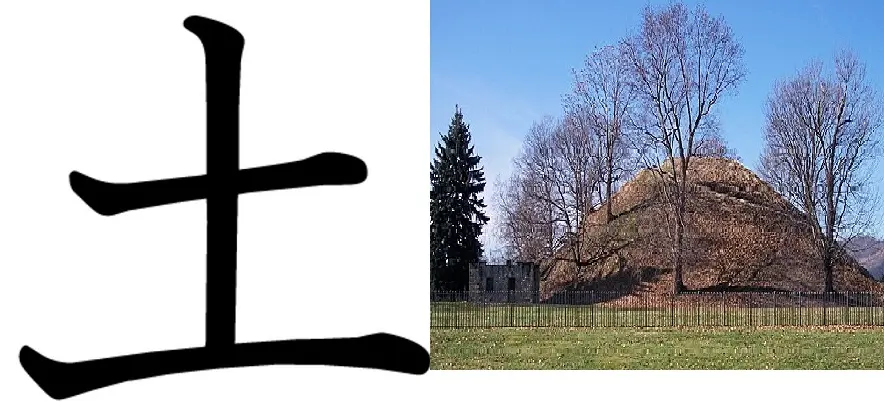
The Japanese kanji for ‘earth’ or ‘ground’ is 土. This earth’s kanji is a pictogram that represents the physical shape of the earth with mounds of sand and stones.
The pronunciation of the kanji of earth or ground (土) depends on the context, as follows:
- The kun’yomi (Japanese reading) is “tsuchi” when the character is used on its own, as in “土” (tsuchi, meaning soil or earth).
- The on’yomi (Chinese reading) is “do” or “to,” as in ” “土曜日” (doyoubi, meaning Saturday) or “土地” (tochi, meaning land or plot of land).
The Kanji 土 is constructed with 3 strokes. This Kanji is a part of the JLPT N5 syllabus (please check the JLPT N5 Kanji list). In Japanese schools, this Kanji is taught in grade 1.
Origin of the Earth’s Kanji 土
In the olden days, farming was the most fundamental primary occupation for human beings. So, from the eyes of early human beings, the earth or ground was a significant life support, and it was very natural to visualize and connect the earth with farming activities.
Now, if you visualize a person plowing the farm, you can’t ignore the image of earth mounds or heaped piles of earth. The following picture explains it:
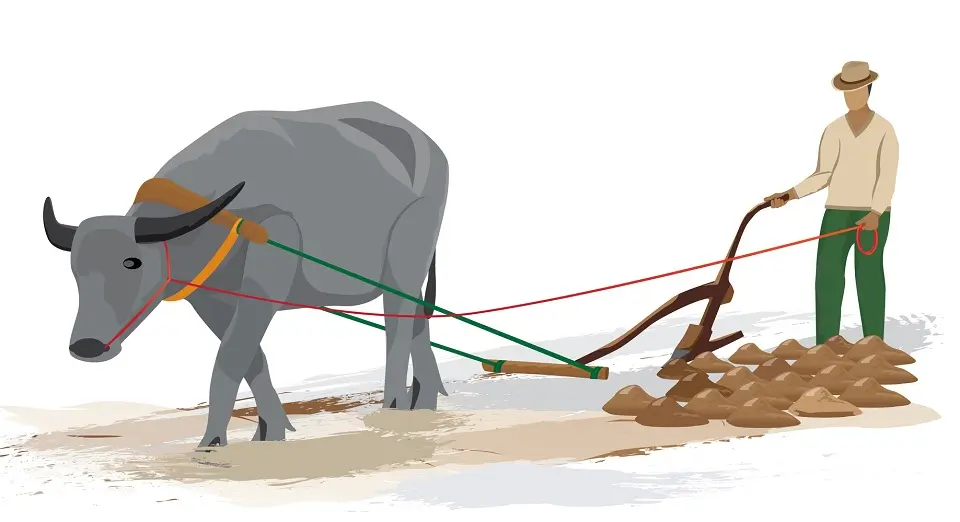

The Kanji of Earth originally depicted a lump of earth or a pile of dirt. Over time, it was simplified and standardized into the character we see today as 土.
Let’s see the evolution of the shape of Earth’s Kanji from ancient times to the current:
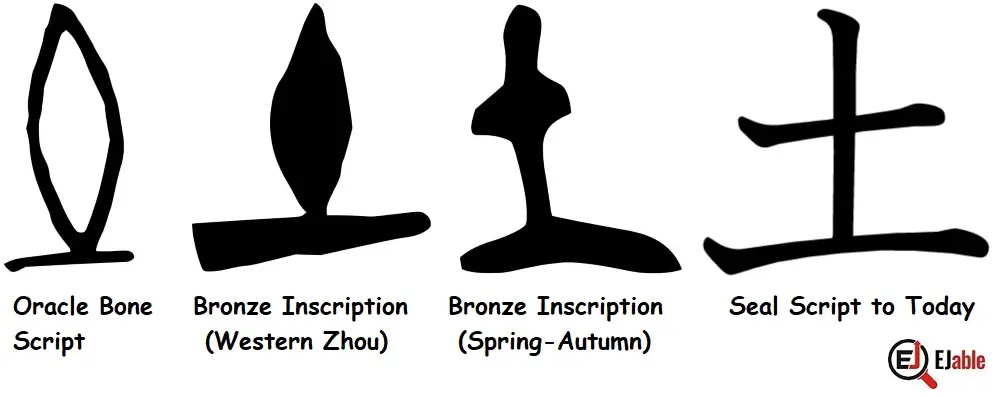

The above image shows the historical shape of the kanji of the earth in Oracle Bone Script, the Bronze inscription during the Western Zhou and Spring-Autumn periods, the small seal script, and how we write it in the present.
Mnemonic: How to Remember the Kanji of Earth (土)
The kanji for the earth or ground is simple but needs some imagination to remember it quickly.
The best way to remember it is to imagine a heaped pile of earth, gravel, sand, rocks, or debris on the ground.
The base horizontal line of the kanji represents the surface of the earth. The vertical line represents the height of the mound, with the second shorter horizontal line representing the decreasing width of the mound as we move up. The following representation of the kanji 土 explains the above principles visually to help you remember this kanji:
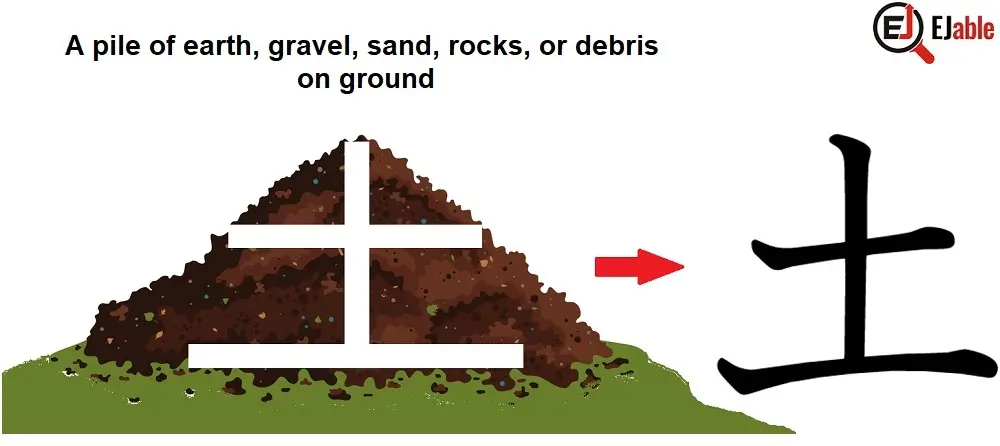

Stroke Order for the Kanji 土
The following illustrations show the order of the 3 strokes to write the Kanji 土:
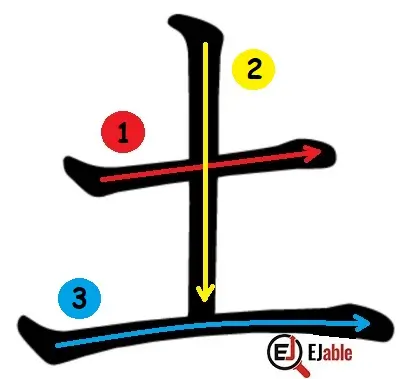

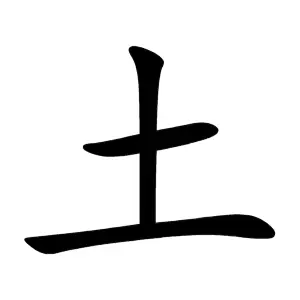

土 as a Radical and Component in other Kanji Characters
The character 土 also appears as a Kanji radical. Some of the names for the radicals of the kanji 土 are as follows:
- “つちへん” (tsuchihen) or どへん” (dohen): A radical when 土 appears at the left-hand side of the kanji.
- “つち” (tsuchi): This name is for the radical of Earth’s Kanji regardless of its position.
Overall, Kanji 土 appears as a radical or as a component in 1380 Kanji characters, including 226 Jōyō Kanji.
Examples of Kanji 土 as a radical
Following are some examples of kanji where 土 (ground/earth) appears as a radical:
- 坂 (saka, meaning “slope”): This kanji combines 土 with 反. The character 反 originally meant a “rebellion” or “contrary action” and might here suggest an incline going “against” the natural level of the ground.
- 城 (shiro, meaning “castle”): Here, 土 is combined with 成 (become or turn into). So the combination of “earth” and “turn into” suggests the construction of fortifications in the ground.
- 地 (chi, meaning “land” or “earth”): This character combines 土 with 也. The character 也 on its own doesn’t have a clear meaning but is used in various characters with a phonetic function.
- 園 (en, meaning “garden”): 土 is combined with 袁. The character 袁 originally represented a long robe, suggesting an area of ground as expansive as a robe is long.
- 均 (kin, meaning “equal”): The Kanji 均 combines 土 with 勹 (wrap), suggesting the idea of parcels of land being divided evenly.
- 場 (ba, or “jou” meaning “place” or “location”): Combines 土 with 昜, a pictograph of the sun rising above the horizon, suggesting a broad, open place.
- 塩 (shio, meaning “salt”): The kanji combines 土 with 兼. The character 兼 means “concurrently,” possibly representing salt obtained from the earth.
- 培 (bae, meaning “cultivate”): This kanji pairs 土 with 咅, which is thought to represent a mouth expelling breath, signifying the process of tilling or cultivating the soil.
- 堕 (da, meaning “degenerate”): This kanji combines 土 with 陏. It implies the process of falling or degradation, like something falling to the ground.
- 坑 (kou, meaning “pit”): Combines 土 with 工, which means “work,” suggesting the act of digging a hole or a pit in the ground.
Combining 土 with Other Kanji Characters
The kanji for “earth” or “ground,” 土 (つち, tsuchi), appears in a variety of compound words in Japanese. There are 218 Japanese words that begin with the Kanji 土, and it appears in 446 words.
Examples of Kanji 土 in Compounded Kanji Characters
Following are the examples where Earth’s Kanji appears in Japanese compounded Kanji characters:
- 土地 (とち, tochi): Land, ground.
- 土曜日 (どようび, doyōbi): Saturday.
- 土砂 (どしゃ, dosha): Earth and sand.
- 土壌 (どじょう, dojou): Soil.
- 土木 (どぼく, doboku): Civil engineering.
- 土産 (みやげ, miyage): Souvenir (originally meant “product of the soil”).
- 土器 (どき, doki): Earthenware, pottery.
- 土堤 (どてい, dotei): Earthen embankment.
- 土手 (どて, dote): Bank, embankment.
- 土佐 (とさ, Tosa): Old name for Kochi Prefecture.
- 土星 (どせい, dosei): Saturn (literally “earth star”).
- 土竜 (もぐら, mogura): Mole (the animal).
- 土足 (どそく, dosoku): Wearing shoes (especially in a place where one usually doesn’t).
- 土砂降り (どしゃぶり, doshaburi): Downpour, heavy rain.
- 土色 (つちいろ, tsuchiiro): Earth-colored, brown.
These words reflect various aspects related to the earth, from the physical properties of soil and land to broader concepts like days of the week (土曜日 for Saturday) and cultural practices.
However, please remember that the meaning of the original kanji (in this case, 土 for earth or ground) can change, sometimes drastically, when combined with other characters or elements. The origins of the words we provided above are simple interpretations, and the exact historical origins can be quite complex.
You may also like to check other Kanji characters on the page “How to Remember Kanji“.


A long-term ex-pat in Japan, Himanshu comes with an IT background in SAP consulting, IT Business Development, and then running the country operations of an IT consulting multinational. Himanshu is the co-founder and Managing Director of ReachExt K.K. and EJable.com. He is also an Advisory Board Member of a Silicon Valley AI/IoT startup.

